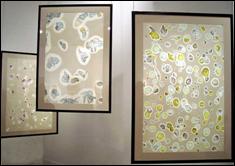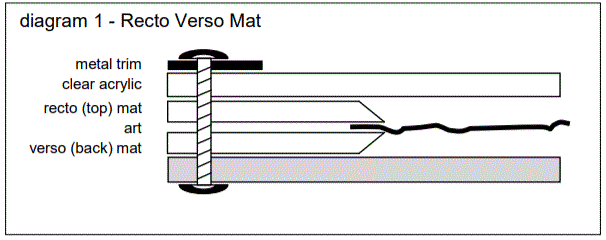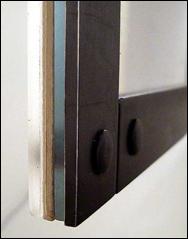 Photo 1
Photo 1
This encaustic monoprint is housed in a translucent acrylic frame unit hung suspended by cables in the center of the gallery to allow light to penetrate through. Art and frame photo courtesy of Paula Roland, Santa Fe, NM.
A few years ago a friend of mine Paula Roland, encaustic artist from Santa Fe, NM had a series of full sheet sheer monoprints that she wanted light to be able to transfuse through for exhibition. She also wanted the framing to be preservation. She and her framer came up with an inventive way to present her pieces in a preservation way while still maintaining the translucent look allowing light to reflect through (photo 1). The framed art is displayed as a free hanging panel suspended from the ceiling in the middle of the gallery. She preferred using natural light rather than housing LED lighting and preferred the frame to become more virtual than a visible part of the presentation.
 Photo 1
Photo 1
This encaustic monoprint is housed in a translucent acrylic frame unit hung suspended by cables in the center of the gallery to allow light to penetrate through. Art and frame photo courtesy of Paula Roland, Santa Fe, NM.
Recto-Verso Mats
A recto-verso mat is a two-sided unit which employs two bevel cut window mats placed back to back allowing the art to be viewed from both sides. Paula's monoprints are matted between 8-ply rag mats in this type of recto-verso design. It is housed between a sheet of ¼" frosted acrylic on the back and ¼" clear acrylic on the front (diagram 1).
 Diagram 1
Diagram 1
The presentation is held together with strips of black metal surrounding the perimeter of the face of the art using short screw bolts to hold it tightly together. The detail of the screws at the back corner of the frame show the screws are perfectly sized to fit the thickness of the package. All screws and metal trim on the front were painted black (photo 2).
 Photo 2
Photo 2
The art is between recto-verso mats, backed with frosted white acrylic, topped with clear acrylic and held together by ⅛" thick metal strips bolted at the corners.
I would have suggested the metal strips to be painted a neutral color—rather than black—to help the illusion of the frame not being there, or better yet used acrylic strips. There may have been a need for a few additional bolts to prevent warping but it would have removed the visible exterior banding.
By using double mats, air is allowed to circulate between the acrylic and the art preventing sticking or condensation. Also the cotton rag 8-ply mats help protect and seal the enclosure to better protect the art from pollution and ozone damage.
END
Copyright © 2013 Chris A Paschke
For more articles on mounting basics look under the mounting section in Articles by Subject.
Additional information on all types of mounting is found in:
The Mounting and Laminating Handbook, Second Edition, 2002,
The Mounting And Laminating Handbook, Third Edition, 2008 and
Creative Mounting, Wrapping, And Laminating, 2000 will teach you everything you need to know about getting the most from your dry mount equipment and materials as an innovative frame designer.
All books are available from Designs Ink Publishing through this website.
Chris A Paschke, CPF GCF
Designs Ink
Designs Ink Publishing
785 Tucker Road, Suite G-183
Tehachapi, CA 93561
P 661-821-2188
chris@designsinkart.com